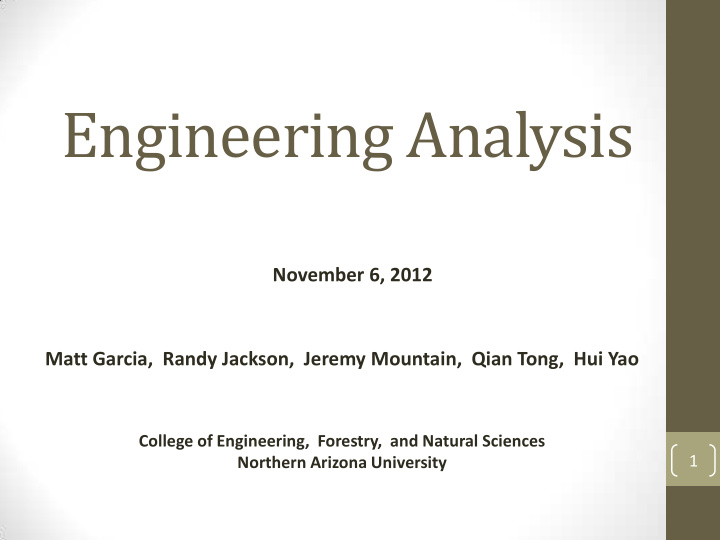



Engineering Analysis November 6, 2012 Matt Garcia, Randy Jackson, Jeremy Mountain, Qian Tong, Hui Yao College of Engineering, Forestry, and Natural Sciences 1 Northern Arizona University
Overview • Problem Statement • Updated Design • Material Analysis • Compression Analysis • Bearing Analysis • Screw Analysis • Cost Analysis • Updated Timeline 2 Matt
Problem Statement Need: The eccentric loading Objectives: of the test specimens causes Basis for fatigue failure. Objectives Units Measurement Goal: Design an improved material testing fixture. Distance from Axially Aligned µm Perfect Alginment Constraints: 1. Specimen size (3 x 3 x 20) mm Tension Compression Repeated Testing # of Tests 2. Exposed Length ( 6 mm) Testing 3. Grips cannot bite into specimen 4. Push rods and grips must be Damage Cost of Specimen $$ / Month non-magnetic Specimen Time to Replace 5. Distance between magnets Machining Cost (10mm) Inexpensive $$ Material Cost 6. Magnetic Field (0.5 - 1.0 T ) 7. Axial Alignment (50 µm) 3 Jeremy
Updated Design Previous Design • Interference with magnets • Spacing > 10 mm New Design • No Interference • Spacing < 10 mm 4 Jeremy
Material Analysis Requirement: • All parts of the fixture need to be non-magnetic Types of Non-magnetic materials: • Copper (Yield Strength) • Silver (Expensive) • Lead (Toxic) • Magnesium (Chemically Active) • Platinum (Too Expensive) • Aluminum Alloy (Cheap, easy to get) 5 Hui
Material Analysis – Cont. 1000 series Pure aluminum. Basic aluminum without any other addition. 2000 series Alloyed with copper. Formerly used in aerospace applications. 3000 series Alloyed with manganese . Rust-proof material. 4000 series Alloyed with silicon . Wear resistant material. 5000 series Alloyed with magnesium . Prevents the oxidation. 6000 series Alloyed with magnesium and silicon . Easy to machine and inexpensive. 7000 series Alloyed with zinc. 6 Now used for aerospace applications. Hui
Material Analysis – Cont. Aluminum 6061 – T6 • A precipitation hardening aluminum alloy. • It has good mechanical properties. • It is one of the most common alloys of aluminum for general purpose use • 6061 - T1 • 6061 - T3 • 6061 - T4 • 6061 - T5 7 Hui
Material Analysis – Cont. Nylon Type 66 • One of the most commonly used polymers. • Easy and cheap to get. • Less Yield Strength than aluminum alloy • Brass • Aluminum 8 Hui
Compression Analysis Stress (N/m 2 ) Force (N) Results: 10 1.111E+06 20 2.222E+06 30 3.333E+06 Length 3 mm 40 4.444E+06 Width 3 mm 50 5.556E+06 mm 2 9 60 6.667E+06 Area m 2 0.000009 70 7.778E+06 80 8.889E+06 90 1.000E+07 100 1.111E+07 9 Matt
Bearing Analysis Pin Pin Pin Pin 10mm 15mm 20mm 25mm Outer Diameter Stress Stress Stress Stress (mm) (MPa) (MPa) (MPa) (MPa) 31.0 16.00 10.67 8.00 6.40 32.0 8.00 5.33 4.00 3.20 33.0 5.33 3.56 2.67 2.13 34.0 4.00 2.67 2.00 1.60 35.0 3.20 2.13 1.60 1.28 36.0 2.67 1.78 1.33 1.07 37.0 2.29 1.52 1.14 0.91 38.0 2.00 1.33 1.00 0.80 39.0 1.78 1.19 0.89 0.71 40.0 1.60 1.07 0.80 0.64 10 Jeremy
Screw Analysis Sum of the forces: 𝐺 y = 18N - µF s = 0 F s = 18 µ N F s [N] Friction 120.0 0.2 36.0 0.5 21.2 0.9 15.0 1.2 11 Randy
Screw Analysis – Cont. Source: www.boltscience.com 12 Randy
Screw Analysis – Cont. Screw: M3 x 0.5 x 6 mm Thread Major Minor External Internal Engagement Pitch Diam. Pitch Diam. D Diam. dr Shear Area Shear Area Length Le dp [mm] p [mm] [mm 2 ] [mm 2 ] [mm] [mm] [mm] 3.000 2.385 3.500 2.567 0.500 18.623 32.986 Nylon Type 66 Brass Yield Str. Force Coeff. Yield Str. Force Coeff. [MPa] [N] Friction [MPa] [N] Friction 45 120 0.15 130 51.43 0.35 External Thread 838.1 2421.0 Force to Fail [N] Internal Thread 8081.6 8081.6 13 Shear to Fail [N] Randy
Screw Analysis – Cont. M3 x 0.5 x 6mm Break Fixture Wall ‘w’ Stress MPa FS 0.50 20.00 12.1 0.55 18.18 13.3 0.60 16.67 14.5 0.65 15.38 15.7 0.70 14.29 16.9 0.75 13.33 18.1 0.80 12.50 19.3 0.85 11.76 20.5 0.90 11.11 21.7 0.95 10.53 22.9 1.00 10.00 24.1 1.05 9.52 25.3 1.10 9.09 26.5 1.15 8.70 27.7 1.20 8.33 28.9 14 1.25 8.00 30.1 Randy
Cost Analysis • Cost of Metals Material $/lb Description Scale Copper 3-3.5 A little Expensive 4 Silver 30-32 Too expensive 2 Lead 2.3-3.0 A little Expensive 5 Magnesium 2-2.6 A little Expensive 6 Aluminum Alloy 0.6-0.9 Inexpensive 9 Platinum 50-60 Too Expensive 1 15 Qian
Cost Analysis – Cont. • Cost of Aluminum Alloys Aluminum Alloy Alloyed Component Price: $/kg 1000 Series Pure 99% 2.6-4 2000 Series Copper 2.5-4.2 Manganese 3.5-3.6 3000 Series Silicon 3.0-5 4000 Series Magnesium 2.5-3.5 5000 Series Magnesium Zinc 2.5-3.5 6000 Series Zinc 2.5-5.5 7000 Series 16 Qian
Cost Analysis – Cont. • Cost of Screws Screw Price / piece [$/piece] Bronze (high Strength) 0.029-0.032 Brass 0.1-1 Nylon 0.005-0.006 17 Qian
Conclusion • Pushrod: Aluminum 6061 – T6 • Sleeve: Aluminum 6061 – T6 • Pin: Aluminum 6061 – T6 • Screw: Nylon 66 18 Qian
Updated Timeline 19 Matt
References 1. http://www.engineershandbook.com/Tables/frictionc oefficients.htm 2. http://www.engineersedge.com 3. http://www.alibaba.com Shigley’s Mechanical Engineering Design, 9 th Edition. 4. 5. http://www.tcdcinc.com 6. http://www.engineeringtoolbox.com/friction- coefficients-d_778.html 20 Matt
Recommend
More recommend